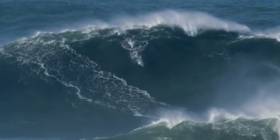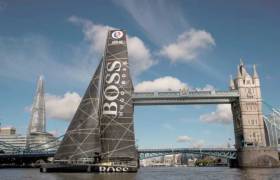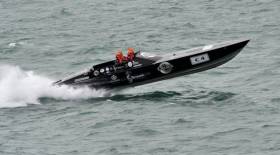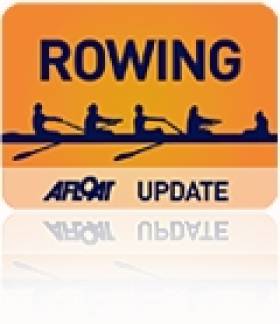Displaying items by tag: world record
Irish/British Rowers Set New World Record in Atlantic Challenge
An Irish/British duo with no prior rowing experience have set a world record as the fastest women’s pair to row across the Atlantic, according to Row Report.
Jessica Oliver — who has Irish connections — and Charlotte Harris set a time of 45 days, seven hours and 25 minutes in the Talisker Whiskey Atlantic Rowing Challenge.
They arrived in Antigua and Barbuda last Wednesday 26 January at the end of a gruelling 3,000-natical-mile route from the Canary Islands.
The pair, who have so far raised more than £43,000 (€51,500) for their chosen charities, set a record-worthy pace in their boat Wild Waves despite the lack of following wind, not to mention dealing with a capsize mid-ocean — and a perilous shark encounter.
They’re not the only British/Irish pair in the transatlantic challenge, meanwhile, as the Tideway Odyssey duo of Saf Greenwood and Victoria Carroll — granddaughter of rowing coach Noel Casey — are less than 430 nautical miles from the finish.
Row Report has more on the story HERE.
Safehaven Marine reports that Thunder Child II and crew have successfully achieved their world record attempt from Ireland to Iceland.
The XSV20’s sub-32-hour time over the 1,500km from Killybegs to Reykjavík is pending ratification by UIM but is already vindication of its state-of-the-art powerboat’s wave-piercing design.
The crew report today (Friday 9 July) that “the hardest leg was the North Atlantic where we were punching a head sea swell all the way”.
Tomorrow, Saturday 10 July, Thunder Child II will continue its voyage north, above the Arctic Circle, to the ultimate destination of East Greenland.
Northern Ireland Swimmers First To Cross Challenging Sea Route From Scotland To Giant’s Causeway
Members of an open sea swimming team have become the first to complete a challenging route between Scotland and the Giant’s Causeway, as the Greenock Telegraph reports.
The Oa Giants set out from Islay last Saturday 8 August and crossed the Oa Channel by relay, reaching Northern Ireland’s North Coast on Sunday 9 August with a final time of 16 hours and 57 minutes.
Comprising Keith Garry, Dominic Mudge, Bill Donnelly, Chris Judge, Colin Lindsay and John McElroy, the team were already record-breakers heading into their challenge.
That was after setting a time of nine hours, two minutes and 41 seconds across the North Channel between the Gobbins and Portpatrick as a practice swim the previous weekend.
And their achievements all the more impressive knowing that the youngest of the group, Chris Judge, is 38 years old.
Judge also told of the “real mental battle” posed by the difficult north-south Oa Channel crossing, not least contending with the potentially lethal stings of lion’s mane jellyfish.
The Greenock Telegraph has more on the story HERE.
Mullaghmore Big Wave Regular May Have Set New World Record In Portugal
#Surfing - A regular visitor to Ireland’s big wave surfing hot spots may have broken the world record for the biggest wave ever surfed, as The Irish Times reports.
Cornish surfer Tom Butler rode a giant swell at Nazaré in Portugal last Friday 14 December that was estimated by onlookers to be 30.5 meters high — more than six meters bigger than the previous record.
It follows previous unverified records claimed by German surfer Sebastian Steudtner earlier this year, and Irish-American surf pro Garret McNamara in 2012.
Butler will have to wait till April’s World Surf League Awards to see if he’s set a new bar, but on social media he said he was already “blown away” by the attention.
Previously, an image of Butler in the barrel of a cresting wave at Mullaghmore Head was notated for a Nomad Big Wave Award in 2016, and also made the front page of The Irish Times.
Thomson Sets New Monohull Speed Record On Hugo Boss
British offshore skipper Alex Thomson and his crew sailing the IMOCA 60 Hugo Boss have officially broken the 24-hour distance record for a 60ft monohull, as Sail-World reports.
Thomson — who sailed with fellow 2020 Vendée Globe challenger Nin O’Leary on Hugo Boss last year — raced 539.71 nautical miles over the course of 24 hours, breaking his own extant record set last year by 2.9nm.
The new record was ratified last week after the feat achieved on 19-20 July during a transatlantic crossing from New York to the UK. Sail-World has more on the story HERE.
Irish Powerboat Racing Team Claims New Cork-Fastnet-Cork Record
#Power - Irish powerboat racing team Allblack Racing claimed a new record on the Cork-Fastnet-Cork route this past summer.
The team’s Allblack SL44 powerboat set a time of two hours, six minutes and 47 seconds, with an average speed of 100.99 kmh in moderate to rough Atlantic conditions. The new record was ratified on August 29 by the Union Internationale Motonautique (UIM).
And the Irish Powerboat Club has since commissioned the FPT Allblack Trophy in the event the record is broken in the future.
For now, the trophy will be kept at the world’s oldest yacht club, the Royal Cork.
Allblack Racing’s record-breaking powerboat is powered by two FPT Industrial N67engines, which have a 6.7l displacement, four valves per cylinder and a maximum power of 560hp.
The Arklow-based team, headed by team driver John Ryan, already holds another world record for the Round Ireland route. More recently, they placed third at the Cowes Torquay Cowes 2017 UIM Marathon.
Last year the team set its sights on completing 11 world records in offshore speed and endurance by 2020.
NYC Aims For World Record Pontoon Splash This Weekend
#NYC - The National Yacht Club is hosting a world record attempt Pontoon 50 Splash as part of its Junior Section Golden Jubilee celebrations this weekend.
All NYC members aged “from five to 105” are invited to join in the fun as the club aims to set a new world record for the greatest number of people in a pontoon jump.
Wetsuits are optional but lifejackets are compulsory for the pontoon splash set for this Sunday 2 July at 1.45pm. Contact Brendan O’Connor at [email protected] for more information.
The NYC will also host a family flotilla to Dalkey Island as part of its events to mark 50 years of the club’s Junior Section this weekend, as previously reported on Afloat.ie.
Maersk Ship Sets World Record For Most Containers In Single Load
#Shipping - BusinessETC.ie brings our attention to this amazing video of the Maersk cargo vessel that's set a world record for the most containers carried on a single ship.
Brand new cranes were required at the Spanish port of Algeciras to load the Triple-E Mary Maersk, which departed for Malaysia on 21 July with an incredible 17,603 containers -- 20-foot equivalent units, or TEUs -- on board.
But even then the vessel set sail from Europe to Asia some 700 shipping containers short of its full capacity.
BusinessETC.ie has more on the story HERE.
McDonald Sets New Ireland Indoor Rowing Record
#ROWING: Kenny McDonald, who is the world champion indoor rower in the 40 to 49 lightweight category, today set a new Irish record in this class. The Shannon Rowing Club man clocked six minutes 20.7 seconds in a special test at St Michael’s Rowing Club in Limerick. This knocked exactly a second off Philip Healy’s old mark. Jonathan Doyle, also competing today, set a time of 6:24.0. The world record, which belongs to Denmark’s Eskild Ebbesen, is 6:18.8.
#ROWING: Kenny McDonald, the world champion indoor rower in the 40 to 49 lightweight class, will launch a bid on Sunday to break the Irish and world records in this class. McDonald, of Shannon Rowing Club, and Dubliner Jonathan Doyle, the man he replaced as champion earlier this year, will take each other on at St Michael’s Rowing Club in Limerick at 1 p.m. The Irish record is 6:21.7, held by Philip Healy, and the world record time is 6:16.8. It was set in January at the European Championships in Copenhagen by five-time Olympic medallist Eskild Ebbesen.
McDonald, who is a garda and an instructor in the Garda College in Templemore, set a time of six minutes 24.5 seconds when he won his title in Boston in February, but felt he could have gone faster. “The race went well, it was nice to win it, (but) I was going out at the back of my mind to break the world record. It went well for 1200 metres but the wheels started to come off at that stage. The last 800 metres I lost the focus. I definitely had a faster time in me.”




































































